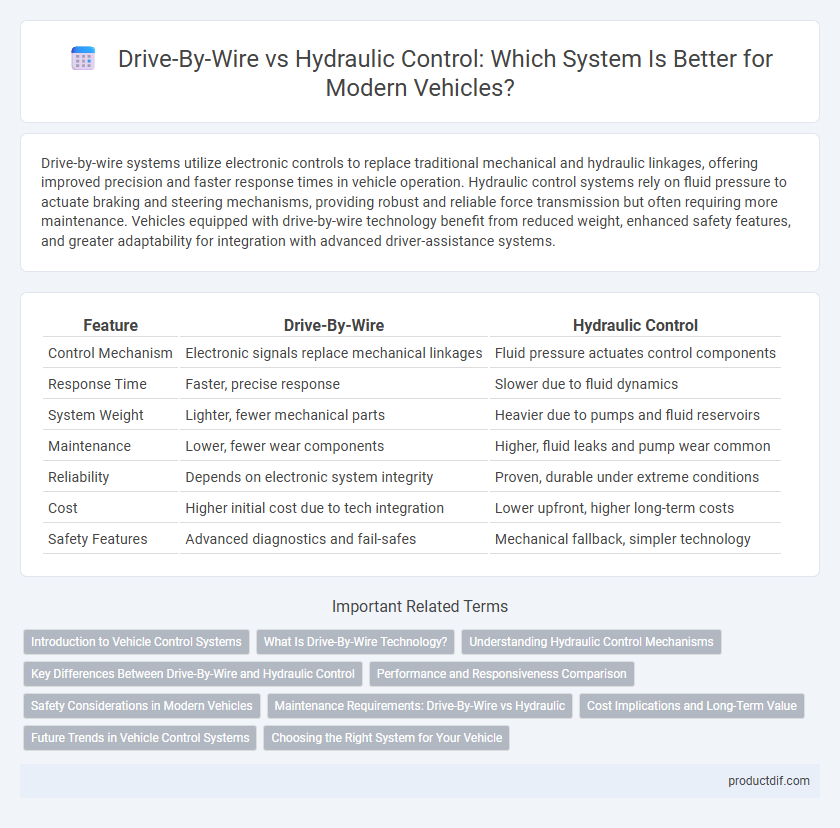Drive-by-wire systems utilize electronic controls to replace traditional mechanical and hydraulic linkages, offering improved precision and faster response times in vehicle operation. Hydraulic control systems rely on fluid pressure to actuate braking and steering mechanisms, providing robust and reliable force transmission but often requiring more maintenance. Vehicles equipped with drive-by-wire technology benefit from reduced weight, enhanced safety features, and greater adaptability for integration with advanced driver-assistance systems.
Table of Comparison
| Feature | Drive-By-Wire | Hydraulic Control |
|---|---|---|
| Control Mechanism | Electronic signals replace mechanical linkages | Fluid pressure actuates control components |
| Response Time | Faster, precise response | Slower due to fluid dynamics |
| System Weight | Lighter, fewer mechanical parts | Heavier due to pumps and fluid reservoirs |
| Maintenance | Lower, fewer wear components | Higher, fluid leaks and pump wear common |
| Reliability | Depends on electronic system integrity | Proven, durable under extreme conditions |
| Cost | Higher initial cost due to tech integration | Lower upfront, higher long-term costs |
| Safety Features | Advanced diagnostics and fail-safes | Mechanical fallback, simpler technology |
Introduction to Vehicle Control Systems
Drive-by-wire systems replace traditional hydraulic controls with electronic interfaces, improving vehicle responsiveness and reducing mechanical complexity. Electronic sensors and actuators enable precise manipulation of steering, throttle, and braking, enhancing safety and fuel efficiency. This shift supports advanced driver-assistance systems (ADAS) and autonomous vehicle technologies by integrating control inputs into centralized computing platforms.
What Is Drive-By-Wire Technology?
Drive-by-wire technology replaces traditional mechanical and hydraulic control systems in vehicles with electronic controls, using sensors, actuators, and control units to transmit driver inputs digitally. This system enhances precision, reduces vehicle weight, and allows for easier integration with advanced driver-assistance systems (ADAS). Manufacturers benefit from improved fuel efficiency and simplified vehicle architecture through drive-by-wire innovations.
Understanding Hydraulic Control Mechanisms
Hydraulic control mechanisms in vehicles rely on fluid pressure to transmit force from the driver's input to the braking or steering systems, ensuring precise and consistent response. These systems use master cylinders, hydraulic lines, and actuators to convert mechanical action into hydraulic pressure, allowing for smooth modulation of braking or steering effort. Compared to drive-by-wire systems, hydraulic controls offer tactile feedback and proven reliability, though they can be heavier and require more maintenance due to fluid and component wear.
Key Differences Between Drive-By-Wire and Hydraulic Control
Drive-by-wire systems replace traditional mechanical and hydraulic linkages with electronic controls, improving precision and reducing vehicle weight. Hydraulic control relies on fluid pressure to operate components like brakes and steering, offering robust force feedback and established reliability. Drive-by-wire enables advanced features such as adaptive cruise control and automated driving, while hydraulic systems tend to provide more tactile driver input and are favored in heavy-duty vehicle applications.
Performance and Responsiveness Comparison
Drive-by-wire systems offer superior performance and responsiveness compared to hydraulic control by utilizing electronic signals for instantaneous feedback and precise control. Unlike hydraulic systems that rely on fluid pressure and mechanical linkages, drive-by-wire reduces latency and mechanical wear, resulting in faster reaction times and smoother vehicle handling. This advancement enhances safety and driving experience, especially in high-performance and autonomous vehicles.
Safety Considerations in Modern Vehicles
Drive-By-Wire systems enhance safety in modern vehicles by reducing mechanical complexity and enabling precise electronic control of steering, throttle, and braking functions, which minimizes response time and improves reliability. Hydraulic control, while traditionally robust, is susceptible to leaks and maintenance issues that can compromise system integrity and driver safety. Advanced fail-safe mechanisms and redundant sensors are critical in Drive-By-Wire technology to ensure system reliability and prevent control loss during electronic failures.
Maintenance Requirements: Drive-By-Wire vs Hydraulic
Drive-by-wire systems require less frequent maintenance than hydraulic controls due to fewer moving parts and no need for fluid changes or leak checks. Hydraulic control systems demand regular inspections for fluid levels, potential leaks, and component wear to prevent system failure and maintain optimal performance. The electronic nature of drive-by-wire allows for easier diagnostics and software updates, reducing downtime compared to hydraulic systems.
Cost Implications and Long-Term Value
Drive-by-wire systems offer lower manufacturing and maintenance costs due to fewer mechanical components compared to traditional hydraulic controls. While initial investment in drive-by-wire technology can be higher, the reduction in weight and improved fuel efficiency contribute to significant long-term savings. Hydraulic control systems incur ongoing expenses related to fluid replacement and mechanical wear, ultimately increasing total cost of ownership over the vehicle's lifespan.
Future Trends in Vehicle Control Systems
Drive-by-wire systems are increasingly replacing traditional hydraulic controls in vehicles, offering enhanced precision, reduced weight, and improved energy efficiency. Advances in sensor technology and electronic control units (ECUs) enable faster response times and greater integration with autonomous driving features. Future trends indicate widespread adoption of fully electronic control systems, leveraging artificial intelligence and machine learning for adaptive vehicle dynamics and predictive maintenance.
Choosing the Right System for Your Vehicle
Drive-by-wire systems offer precise electronic control, reduced weight, and improved fuel efficiency, making them ideal for modern electric and hybrid vehicles. Hydraulic control systems provide reliable, robust performance with established safety and fail-safe mechanisms, preferred in heavy-duty trucks and off-road vehicles. Selecting the right system depends on vehicle type, performance requirements, maintenance preferences, and cost considerations.
Drive-By-Wire vs Hydraulic Control Infographic

 productdif.com
productdif.com